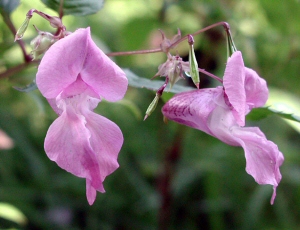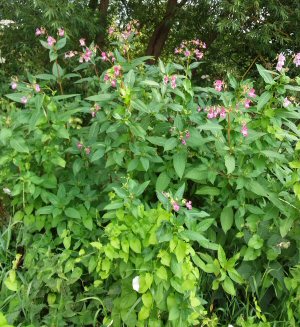The Biological Control of Himalayan Balsam
A talk to the EEG by Dr Carol Ellison, 21 May 2018
In introducing the evening's subject, Alan Broodbank painted a picture of a strange ritual that can be seen every so often on the banks of the Loddon, in which a group of people, risking the stinging nettles, pull up and destroy beautiful plants. This was a reference to the Wednesday volunteers clearing invasive Himalayan Balsam. He then welcomed Carol Ellison, Principal Scientist at the Commonwealth Agricultural Bureau (CABI). Formerly of Silwood Park, where she and Alan were colleagues for a while, Carol has had 25 years' experience in biological control, and has also appeared as an expert on Gardener's World.
Carol explained that CABI, established in 1910, was a not-for-profit, intergovernmental organisation, representing 48 member countries. These were primarily members of the Commonwealth, but Chile, China, Colombia and others have now joined. With 500 employees globally, CABI undertakes scientific publishing, communication and consultancy.
Himalayan Balsam
 Turning to the topic in hand, Carol explained that Himalayan Balsam had been introduced into Britain as an ornamental plant for stately homes. It had spread throughout the surrounding riversides and woodland, to the extent that it is now a pest, so it is illegal to release further specimens. The plants produce 5000 seeds per square metre, and germinate early (at 4°C); it is therefore prolific, although it can be cleared from a site over three years. In spreading, it competes with native plants for light and space and, along the riverbank, contributes to silting and flooding. However, Himalayan Balsam also attracts pollinators, so it is liked by beekeepers, although it should be said that the beekeepers' association now discourages its use. The economic damage caused by Himalayan Balsam is estimated at £1.7bn per annum, and the Environment Agency spends £300,000 per annum on its removal. The UK is the worst-affected country in Europe; Switzerland is second. Turning to the topic in hand, Carol explained that Himalayan Balsam had been introduced into Britain as an ornamental plant for stately homes. It had spread throughout the surrounding riversides and woodland, to the extent that it is now a pest, so it is illegal to release further specimens. The plants produce 5000 seeds per square metre, and germinate early (at 4°C); it is therefore prolific, although it can be cleared from a site over three years. In spreading, it competes with native plants for light and space and, along the riverbank, contributes to silting and flooding. However, Himalayan Balsam also attracts pollinators, so it is liked by beekeepers, although it should be said that the beekeepers' association now discourages its use. The economic damage caused by Himalayan Balsam is estimated at £1.7bn per annum, and the Environment Agency spends £300,000 per annum on its removal. The UK is the worst-affected country in Europe; Switzerland is second.
Biological Control
 Many introduced species of flora or fauna flourish in their new location without the natural predators or diseases that afflict them in their native habitat. To reduce their levels and restore the natural balance, the idea of biological control has been developed, by which some of these adversaries from their native environment are released into the adoptive territory. It is noticeable how much more vigorous Himalayan Balsam is in Britain; individual plants in its native range (from Kashmir to NW Nepal) are smaller, and suffer more from pests and diseases. Many introduced species of flora or fauna flourish in their new location without the natural predators or diseases that afflict them in their native habitat. To reduce their levels and restore the natural balance, the idea of biological control has been developed, by which some of these adversaries from their native environment are released into the adoptive territory. It is noticeable how much more vigorous Himalayan Balsam is in Britain; individual plants in its native range (from Kashmir to NW Nepal) are smaller, and suffer more from pests and diseases.
In seeking to undertake a programme of biological control for Himalayan Balsam, CABI looked for natural enemies and tested for those that were specific to the target plant; it is important not to cause collateral damage to native plants. 'Rust' was host-specific, affecting Himalayan Balsam leaves and reducing photosynthesis. Developing through five stages, Rust has co-evolved to have a similar life-cycle to that of the Balsam, and the two exist together. CABI then spent four years checking and confirming host specificity, since the programme had to meet quarantine requirements. 75 native plant species were checked for susceptibility to rust: only two species of impatiens were found to be susceptible:
- Scabrida - rarely found in Britain, and not in the field
- Balsamina - a non-native ornamental 'prima donna' species.
The risk was considered slight, so the programme went ahead.
Rust can travel considerable distances, even across the English Channel, so a Pest Risk Assessment was undertaken. In 2014, CABI was licensed to release the rust, first to establish whether it would survive in the UK, to which the answer was Yes. It was then released at 25 sites during 2014 - 16, spread by the manual planting of infected plants. These sites included locations in the North-East, Yorkshire, Wales (the Gower peninsula) and Berkshire. By 2015 its spread was limited, so CABI checked the effect of climate (temperature and moisture).
DNA studies
Tests for genetic variation in the population were also undertaken, and these indicated there had been more than one introduction, and so infection rates varied according to the respective gene pool. A new, additional strain of Rust was selected, from Pakistan rather than India. Further tests showed that one site in Wales was resistant to the Indian strain, but susceptible to the Pakistani strain, so a molecular study was undertaken, with DNA taken from the Natural History Museum. As a result, it has been established that there are three strains of Himalayan Balsam in the UK, all from Kashmir - in particular, the 'Valley of the Flowers' (Wangal Valley).
In 2016, rust was released at two sites, Gatwick and Lampeter, and showed excellent infection rates. A permit to spray has now been applied for, as it has not yet reached the critical density to allow it to self-spread, and volunteers are being sought to help with the task. Local action groups became involved at 21 sites during 2017, but it will take several (perhaps ten?) years to become fully established.
Edwin A.R. Trout
Picture of Himalayan Balsam flower from ukwildflowers.com.
|